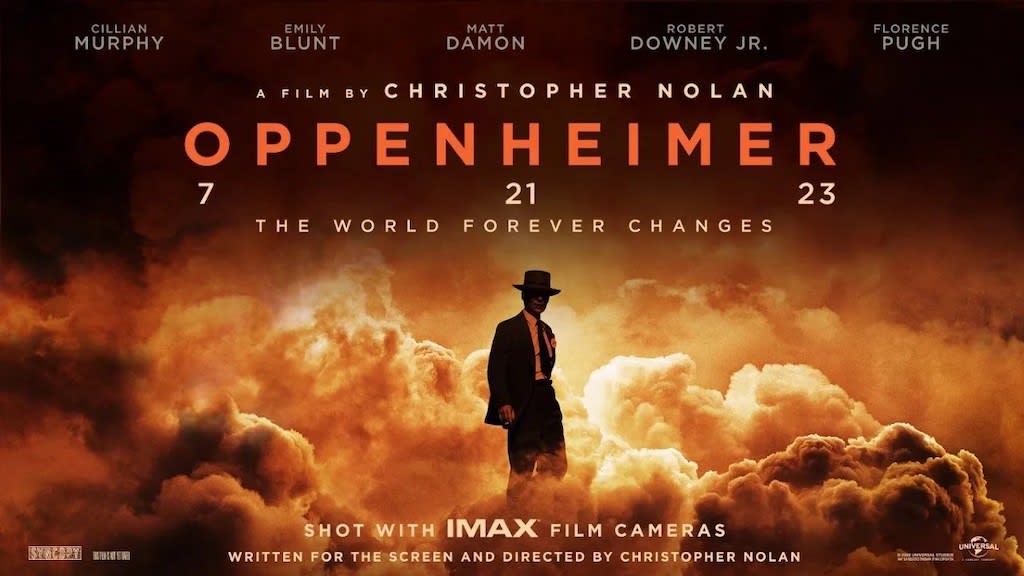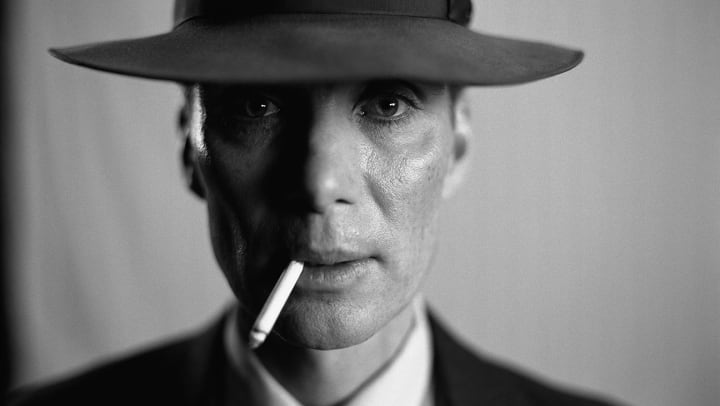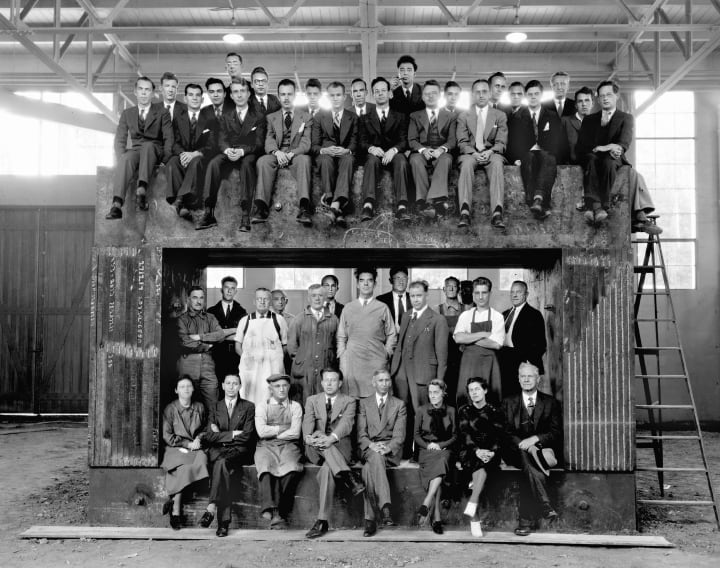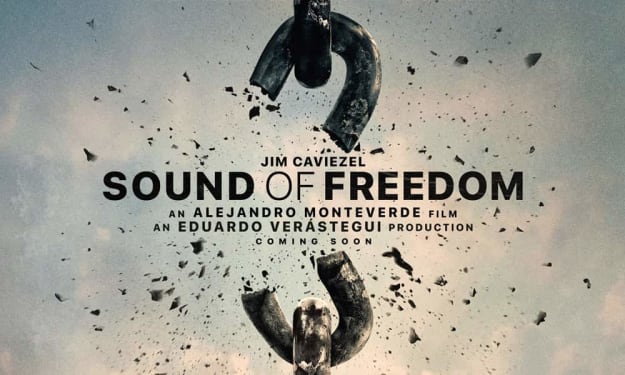Atoms and Adversaries - the Power of OPPENHEIMER
The Ascent, Apex and Fall of America's Controversial Scientist

J. Robert Oppenheimer lies in bed, his lover Jean hovering intently over him holding the Bhagavad Gita, the sacred Hindu text written in Sanskrit. She demands his translation of an obscure line. Oppenheimer struggles with the dead language and hesitantly speaks the now infamous quote.
“Now I am become death. The destroyer of worlds.”
The translation holds a dual meaning. For the father of the atomic bomb the surface interpretation is self evident: the creation of a weapon of mass destruction the world has ever known. But here director Christopher Nolan I believe subtly gives it a deeper implication. “I am” is the Biblical name of God and Oppenheimer is now about to inhabit the role of the destructive divine. Equally creator and destroyer. And that is the complexity of the world that Nolan masterfully creates.
Oppenheimer is an epic, complex and visually stunning narrative of the nuclear scientist who ushered in the nuclear age from which there would be no return and the profound and unimaginable weight that it would impose upon its creator. The arc of the film follows very much in the thematic structure of Thomas Pynchon’s “Gravity’s Rainbow” which follows the rise, apex and trajectory of the V-2 rocket (also referenced in the film). Construction moves to pinnacle and finally the deconstruction of the main character. Oppenheimer is the cinematic equivalent of a 10,000 piece 3D puzzle and a film which demands your close attention. This is not light viewing and at three hours could feel challenging for some. You’re not going to keep track of everything so don’t try. But for those who commit to Nolan’s vision you are in for an intense emotionally charged ride with immense payoff.
The film opens with Oppenheimer played with utter intensity by Cillian Murphy (28 Days Later and Peaky Blinders) who is haunted by visions of the hidden world of the potentiality of particle physics – energy arcs, light particles, fire, destruction and punctuated with thunderous rumbles which create a visceral unease and which evoke an inexorable trajectory: A new form of death is ahead and it’s unavoidable. Nolan weaves between two time frames: Oppenheimer being questioned by a secret court about his flirtations with the American Communist party while challenging his character and loyalty to the United States and interwoven with his time as a student of particle theory rising in the ranks of academia and ultimately being drawn in the Manhattan Project. With this structure there is no discernible “present.” The hero is being constructed and deconstructed simultaneously before our very eyes.

We are introduced to a vast ensemble cast of almost forty characters that weave the narrative together into a dense and complex tapestry. It’s a master class of top talent with extraordinary performances by Kenneth Branagh, Josh Hartnett and Cassie Affleck among the multitudes. Emily Blunt is pitch perfect as Kitty Oppenheimer who threads the difficult needle of supporting her husband while processing his dalliances with his doomed lover Jean Tatlock played with immense vulnerability and power by Florence Pugh. Surprise appearances abound as well. I was thrilled to see Matthew Modine on screen again as well as the shock arrival of Gary Oldman as President Harry Truman. Even Oscar winner Rami Mallek makes an appearance in a minor but pivotal roll. It just demonstrates that when Nolan calls, you pick up the phone.
The budding professor Oppenheimer, who is being prodded into joining the Communist party by his family and lover Jean, is approached by military commander Leslie Groves (the excellent Matt Damon) who is willing to overlook such things and recruits him into leading the Manhattan Project and overseeing a team of eclectic personalities who are all geniuses in their field. Naturally the question of ethics arises. It’s one thing to study how fission reactions could theoretically be accomplished and actually making a bomb which has only a singular lethal purpose. But the counter to this is however painfully real: The nazis are working on their own bomb and if we don’t get to the bomb first then they most certainly will. And with that the clock begins fatally ticking. The military then create and entire town in the middle of the New Mexico desert for the scientists and their families – the legendary Los Alamos.

We also meet Lewis Strauss played masterfully by an almost unrecognizable Robert Downey Jr. A machiavellian man with his eyes set on a cabinet seat who has prodded Oppenheimer into the Manhattan Project but only to further his own ambitions. If the bomb wins Strauss wins. Here we slowly realize that Strauss is the secret antagonist of the film with all scenes from his point of view shot on custom made black and white IMAX film. At one point Straus witnesses a tense exchange between Oppenheimer and Albert Einstein (Tom Conti) thinking the conversation is about him, but the film intentionally leaves the exchange a mystery as Strauss’s intentions become increasingly revealed.
But suddenly a deeper disturbing problem arises casting a pall over the entire team – What if the detonation of the bomb doesn’t stop with the initial explosion? What if it continues and ignites the very atmosphere itself in an implacable fission reaction extending ever outwards destroying all that exists? When the calculations of this happening are “close to zero” but not absolutely so, the work nervewrackingly continues. There is no zero except potentially for the entire world. The film has achievedits ascent.
Then comes the tense and riveting second act and probably one of the best cinematic achievements I have ever seen. Welcome to the Trinity test outside of Los Alamos. This is where everything becomes very very real and pulled off with no CGI whatsoever. All effects including the H bomb detonation were achieved purely through camera work and practical effects which Nolan is famous for. In an industry which is so heavy laden with often badly rendered CGI, a world existing entirely in the physical is a tangible delight. So successful is the achievement that many asked if he set off an actual atomic bomb...which he of course didn’t. But knowing Nolan’s history if he could have done it he most certainly would have.

Nolan wisely make it less about the bomb and more about the people who wait in both excitement and terror. And in the scene of the Los Alamos workers and scientists literally thundering their feet for Oppenheimer’s victory speech we return to his dark visions of the destruction he unleashed with much of it played out in the silence of his inner world. But by this time Germany has lost, Hitler dead and the bomb handed over to politicians. The decision is made to bomb Japan to end the war without the immeasurable cost to lives that a land invasion would theoretically incur. A debate that continues today. But Oppenheimer despite his national lauding is now suddenly irrelevant. The bomb is no longer his but in the hands of politicians and his regret sets in for what he has wrought.
The mastery of camera (Hoyte Vaan Hoytem), editing (the incredible Jennifer Lame) and sound (Randy Torres) is nothing short of astounding. Oscar winner Ludwig Göransson’s score is ever present creating a nearly constant tension which some found aggravating but I found it haunting and just like the film, never lets you rest. Here we have achieved a glorious apex.
Then we get to the contentious third act. It extends the running time by another hour and yes, you can feel it. The dramatics of the bomb are over and now it is a lot of men bantering in rooms and congressional hearings. Oppenheimer is thrown to the wolves as Strauss closes the noose around him and often leading previously loyal colleagues to betray him. All aspects of his character are dismantled and questions arise about whether he should have been given security clearance in the first place because of his leftist leanings now viewed through the lens of the McCarthy era. The subject of questioning someone’s security clearance is not the stuff of high drama but that’s what we delve into and Nolan keeps it tight and smart regardless. This is now the descent and deconstruction.
Still with a shred of dignity Truman rapturously calls him into his office to congratulate him, but once Oppenheimer shows an ounce of regret, Truman turns on him. Paraphrasing, “This isn’t about you. You didn’t drop the bomb I did!” And with a final dismissal, “Get this cry baby out of here” and the degradation continues.
In a kind of dream sequence and before the withering questions of the council he is literally laid bare with his lover Jean for all to see. Some have criticized the nudity, but in context it’s a visceral and poignant metaphor and not gratuitous at all.
But it’s not over for Oppenheimer. In a surprise twist before Congress, Rami Malek’s David Hill turns the tables on Strauss accusing him of character assassination and his ambitions for a cabinet seat are now over. Oppenheimer though tarnished is finally redeemed. And in a further blow to Strauss’s ego, we discover the private conversation between Oppenheimer and Einstein had nothing to do with Strauss at all but with the new destructive world they gave birth to and there’s no returning to innocence. The bomb will forever be an ever present danger, never to go away but only to be further developed by other nations hemming us in with the terror of mutual annihilation. “Now I am become death. The destroyer of worlds” becomes fully realized.
Ultimately Oppenheimer is both inspiring and exhausting and I cannot think of any cinematic corollary to it. It’s a deep, complex and extraordinarily long think piece demanding our full concentration and an artwork unto itself. To fully grasp the breadth of the film would require multiple viewings which few would be willing to undertake. But tempted I am. Despite its purposeful challenges to its audience, Oppenheimer will likely go down in history as one of greatest, strangest biopics ever made and Nolan’s masterwork.

About the Creator
Kevin Rolly
Artist working in Los Angeles who creates images from photos, oil paint and gunpowder.
He is writing a novel about the suicide of his brother.
http://www.kevissimo.com/
FB: https://www.facebook.com/Kevissimo/
Enjoyed the story? Support the Creator.
Subscribe for free to receive all their stories in your feed. You could also pledge your support or give them a one-off tip, letting them know you appreciate their work.






Comments (2)
seems like a must see
Great review. I haven't seen this yet, but I intend to.